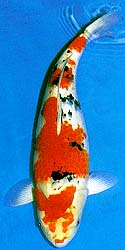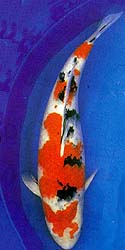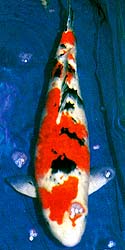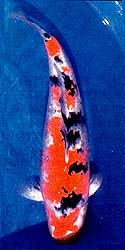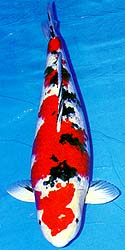"Oops, Red Can Appear!" I was panning a young Kohaku for a hobbyist to look at the other day, when he asked me if I thought there was a possibility of more red coming up on the head, thus further enhancing the pattern. I laughed and said that with the exception of some Showa, red almost never "appears" where there was no red before. If and when red comes up where there was previously no red, it is almost always what is referred to as niban hi, or secondary red. This secondary red usually stays blurred and indistinct just below the surface of the skin or scales, and rather than enhancing the pattern, it usually destroys the koi's future as a tategoi or show koi. Thus assured of this particular kohaku's lack of potential, my would-be client thanked me and continued on his search for the perfect tategoi. While reading back issues of Gekkan Nishikigoi later on that same day, I stumbled upon the exception to the rule, the 1991 Grand Champion of the 27th Fukui Prefecture Combined Nishikigoi Show. This robust 9 year old Taisho Sanke owned by Hiroji Fujimoto of Fukui, was spawned at Dainichi Fish Farms in Ojiya in the early 1980's. It was no wonder that her four step pattern interspersed with lacquer like sumi (black) caught everyone's eye at the koi show. Her body confirmation was near perfect, and she carried her 31 inches with elegance. Note the small mado or "window" of white in the red of the head pattern.
This Sanke was purchased from Dainichi Fish Farms as a 16 inch two year old by Ohara Fish Farms of Fukui Prefecture, and kept in their mud pond for one season. The Sanke grew to about 20 inches, but the red on the head became blurred and niban hi (secondary red) appeared on the nose and face. It was at this stage in the Sanke's development, that Mr. Fujimoto purchased it and took it home to keep in his concrete pond. After a year in Mr. Fujimoto's pond, we can see that not only did the secondary red disappear, but the head pattern underwent a remarkable change with a clear improvement of the red. The body had stretched to 26 inches and lost a bit of it's volume, but the sumi (black) was clearly asserting it's true potential. In the hopes of allowing his Sanke to reach her full growth potential, Mr. Fujimoto returned her to Ohara's care, to be kept in the mud ponds. At seven years old and measuring almost 29 inches, we notice the head pattern has changed again, the red seemingly having receded further back on the head. As luck would have it, the only existing photo of this Sanke as an eight year old, has part of the head obscured by shadows so we are unable to fully document the reappearance of the red on the nose. Measuring 30 inches and showing more black than ever before, it is obvious that this Sanke was destined for glory. The last photo taken before her debut as Grand Champion, shows the nine year old Sanke with red running down almost to the tip of her nose, where there was definitely no red before. The next time someone asks me if I think that more red will appear on any particular koi, I guess I'll have to tell them the story of Mr. Fujimoto's Grand Champion.
BACK TO TOP |
||||||||||||||||||
|
|
||||||||||||||||||

